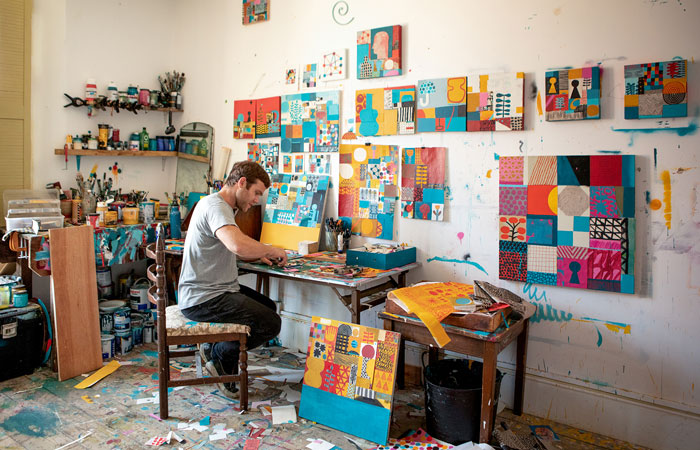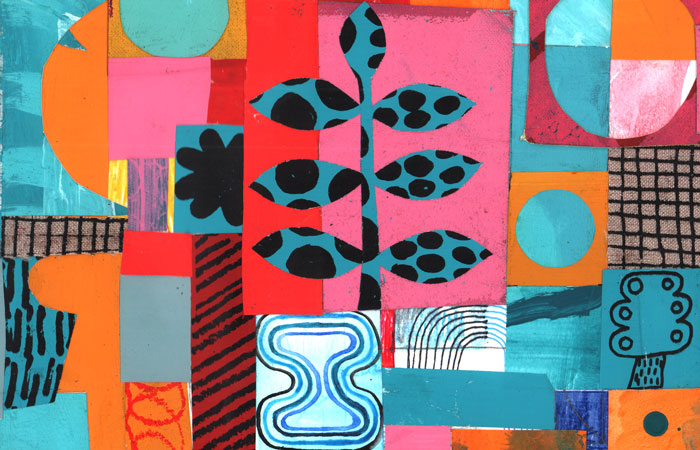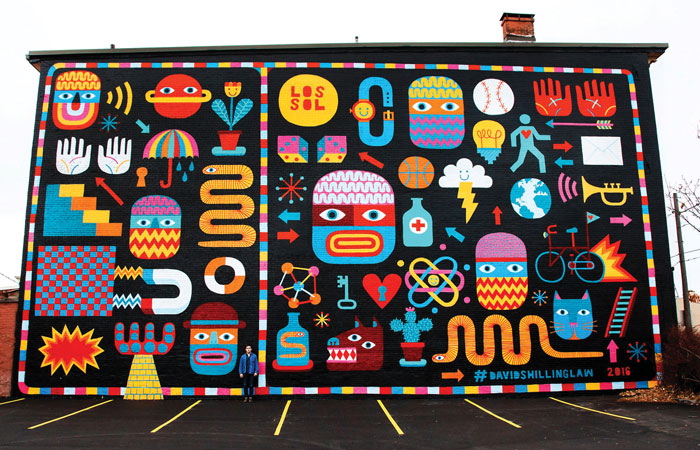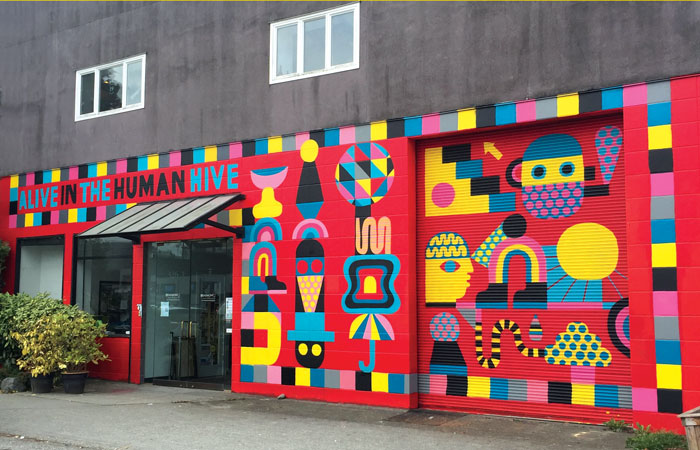Jim Biddulph & David Shillinglaw in Conversation
To date, 2020 has been a year of stark contrast in terms of our global experience of interior and exterior space. The vast majority have lived through their first ever lockdown, with more and more of us slowly but increasingly reconnecting with the outside world as lockdown measures ease.
For many, the appreciation of the great outdoors is more palpable than ever before, whilst simultaneously; deeper and often worrying questions surrounding our collective and individual existence are precipitating through our conscious and unconscious thoughts. Although for some, big life questions and an appreciation for the exterior world have always been present. Artist David Shillinglaw, who creates large-scale murals and works on paper and canvas, is certainly no stranger to such notions. His colourful and playful creations explore human nature, success and failure and the language that people use in the context of their experiences and are regularly created on exterior surfaces.

As well as carrying out numerous commissions and projects here in the UK; not least several Agnes B stores, his work has even taken him to Ethiopia to paint on a drilling rig owned by the charity Viva Con Agua, who promote safe water and sanitation in parts of Africa. A more familiar project may be the large-scale mural he painted for Morgan’s Clerkenwell showroom and I caught up with him to find out more about this and how he goes about making his work.

JB: Let’s start with something that is always of interest to me – materials. Do you tend to stick to a particular medium when making your work?
DS: Everything starts with a pencil and sketchbook and grows from there. Spray paint is a luxury material; its fast, bold and lasts for a long time but my materials change from piece to piece and often the project dictates what I use. The scale of the work, the budget, or if its interior or exterior, play a big part and time is also a big factor. Generally I like the freedom to mix things up and use a variety of tools and materials.

JB: Your work is largely discovered outside, often in the form of murals – a format that seems to have had a real renaissance in recent years – how conscious was this decision for you?
DS: I studied fine art so I was aware of murals and artists that worked outside; Keith Haring has always been there as an influence, but street art wasn’t as popular then as it is now. The first murals I made were inside galleries. I didn’t graduate thinking “I’m going to paint big outside murals.” In reality, it happened quite accidentally and each mural or piece leads to the next. I enjoy working outside; it keeps things interesting for me until the very end. I enjoy working as large as possible, it ups the stakes, makes the work monumental. By painting outside the piece becomes sculptural, the building gives the painting a body; it feels like a collaboration with architecture or nature. When people see it as they walk to work or drive by, it becomes part of the landscape.
JB: Like other mural artists, your work is distinctive in its style; your ‘hand’ and brain are instantly recognizable in the rich imagery. Do you have to be careful not to let the work become too stylistic, or is that integral to your work?
DS: Each piece informs the next and I try and do something different each time, whether it is a mural or a canvas, and I remix my own works too. I rarely make an accurate sketch before painting a mural; instead I like to let the wall dictate aspects of the composition. I react to the shape and surface of the wall and I often work around windows and drain pipes. Stylistically, I feel like I move through phases, using a certain colour palette for a few months or leaning on reoccurring motifs or patterns. I don’t plan it too much, I often realise afterwards that there were common themes that define a period of time. I am always working to try and push things forward, old and new ideas overlap. I feel like it’s a game of visual Chinese Whispers, and for sure some of the best things I achieve happen by mistake.

JB: Readers may also recognise your work based on a large mural you created for the Morgan showroom for Clerkenwell Design Week a few years back. Can you tell me a little more about that collaboration?
DS: Morgan invited me to create an installation in their London showroom although I have worked in their space twice now. They are an amazing family and team to work with, and it is an immense space to transform and add to. There was no major difference between working in their space and making a mural or canvas for myself. The project bought fresh eyes to my work; the differences are with the context of how the work is viewed and the objects and furniture they chose to accompany the paintings.
JB: It’s hard not to bring the pandemic into the conversation and I do wonder whether these strange times are, in a way, suited to exterior projects such as murals and street art?
DS: When painting an outside mural you are usually on your own, wearing a mask, keeping a distance from people, so as long as you can get to and from the wall it doesn’t really affect the work. That said, a few projects I had planned overseas have been cancelled as a result of the pandemic. I am also currently in France and have to quarantine for two weeks when I return, which is annoying, as I have to work from home. But it’s all manageable, I can’t complain at all.
JB: Indeed…in fact, I believe there is an exhibition at Jealous Gallery in London on the horizon? Would you like to tell us about Rewilding?
DS: Rewilding describes the returning of areas of land to a wild state, including the reintroduction of animal and plant species that are no longer naturally found there. This idea has captured my imagination, as I find myself observing the precarious and ever-changing relationship humans have with nature. We arrogantly take advantage of nature, bend it to our will, and push and pull it to suit our growing needs.

The works in this exhibition are a cross pollination of ideas and materials, mixing drawing, painting and collage into one hyperactive patchwork of information. Different mediums wrestle for space, and colours compete for attention. Amidst this chaos there is an attempt to organise space, discover some peace, draw a line under the abundance, and tend to a visual garden. The works celebrate failure and a lack of control. Often uncertain, I am comforted by the words of Carl Jung, “In all chaos there is a cosmos, in all disorder a secret order.”
Rewilding opens 17th September and more information can be found here.





